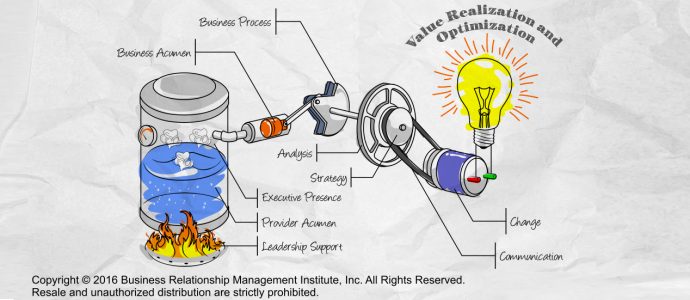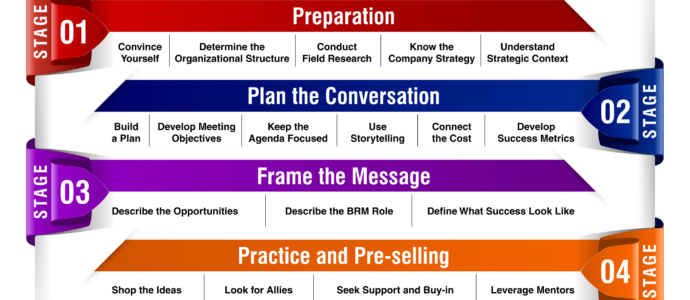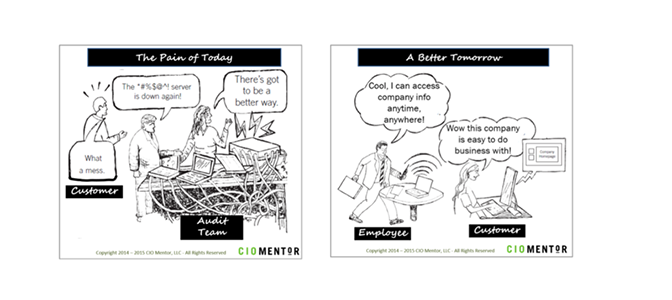BRM Capability
A business relationship management capability is everything it takes, both visible and invisible, to nurture relationships in an organization. Examples of visible components are meetings, artifacts, and professional development, while examples of invisible components are knowledge learned, experience gained, trust, and confidence-building. Used effectively, these components build the endless reserve of energy necessary to evolve culture, build partnerships, drive value, and satisfy purpose.
The business relationship management capability facilitates culture advancement, driving it to one of trust, creativity, innovation, authenticity, and shared ownership across the organization. A mature business relationship management capability converges cross-functional teams to create holistic strategies that deliver organizational value and meaningful results.
Click here to learn more on: BRM Capability Defined | BRM Capability Success
BRM as a Change Agent
Successful BRMs are synonymous with successful change agents, which requires these three critical qualities.
Convergence, Alignment…Are They Really That Different?
Convergence – big buzz word out there right now. But what does it really mean?
5 Common BRM Challenges and How to Overcome Them
Introducing business relationship management to an organization can be difficult. Whether your team is brand-new or has existed for years, here are five common BRM challenges and how to overcome them.
Challenging the BRM DNA™: Common Skills of BRMs in the Industry
Read Business Relationship Management Institute’s latest piece of research on the connection between the BRM DNA™ model and the key factors to consider when building or hiring the ideal BRM.
How an Intense Focus on Business Value Can Accelerate BRM Adoption
Learn how the culture towards IT changes when IT leadership prioritizes and focuses on the business value created, realized, and optimized from IT investments.
The Road to Convergence: BRM’s Role in Making IT a Strategic Business Partner
Technology has changed the business-IT relationship significantly over the years, making it more important than ever for IT to become a converged strategic partner.
BRM Council Corner: Bringing Your BRM Skills to the Budgeting Process
When you’re asked to step outside of your comfort zone, it makes sense to feel uncertain, especially in times of change. Learn how your BRM skills can take you further than you realize.
Should I Stay or Should I Go?
Not only the Clash’s top hit, this is the question for BRMs deciding where to locate themselves: with their business partners or with their teammates. Learn how one organization succeeded in figuring it out.
The BRM Role in Financial Planning
When it comes to budgeting, what is the BRM’s role? We discuss the answer to this question and more through the ABCs of Financial Management: Accounting, Budgeting, and Charging.
Getting the Most Value Out of Business-IT Relationships
In today’s times, the nature of the relationship between business and IT can best be described as co-creational. So what do the business and IT need from each other to succeed?
Your Organization Isn’t Unique. Here’s What Is.
Just like animals, there are different “species” of organizations that have evolved, making various adaptations now evident. Learn what exactly sets you apart in your organization.
The Brexit Effect: The Role of the BRM in Uncertain Times
In light of the Brexit decision, many businesses are now dealing with a period of uncertainty both inside and outside of the U.K. What does this mean for BRMs?
The Journey to Build a High Value-Delivering BRM Organization
Whether you’re leading a team or you’re the BRM, it’s important to determine what success looks like and how to get there before embarking on your next BRM journey.
Marketing and IT: Conflict or Collaboration?
In order for IT to become value-adding for Marketing, strengths-based leadership needs to promote collaboration. Once the spirit of collaboration is in place, leadership should then establish a “connector” role. Read on to learn more about how you can play a part in bringing this role to life.
Lean Out Over the Tips: Infiltrating Your Enterprise with Proactive Interaction
Most BRMs are aware that IT’s path to a strong, strategic relationship with business partners starts on a much smaller scale, built on a foundation of trust that’s earned over time by illustrating competency, engagement, desire, and an approach that’s anything but self-serving. However, what you also need to move beyond the realm of IT order-taker—after deciding that you do want something different, of course—is to introduce proactivity into your service model.
The Case for BRM: A Practical Framework for Your CEO Conversation
Getting your company’s BRM capability off the ground takes planning, patience, and perseverance. Successful BRM programs are game-changing for companies that get it right, but planning and preparation are essential to getting your program off to the right start. Here are four concepts to consider when building your plan…
The Case for BRM: Example Scenarios
The following are examples of real-world scenarios that paved the way for the BRM role at three different companies. This is a companion white-paper to The Case for BRM: A Practical Framework for Your CEO Conversation.
Webinar Recordings
An archive of select recorded BRM webinars.







